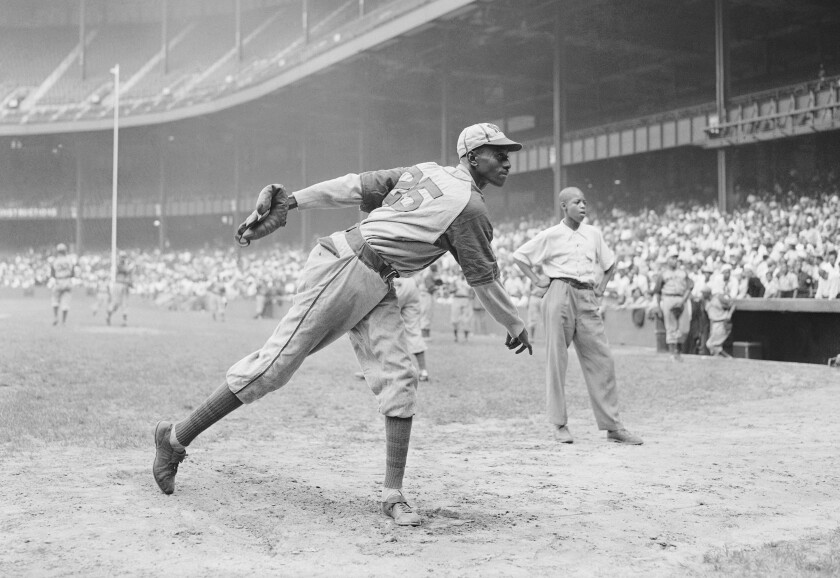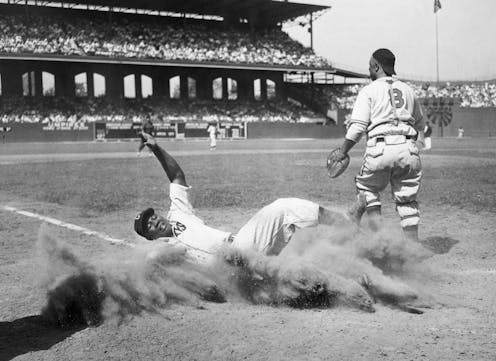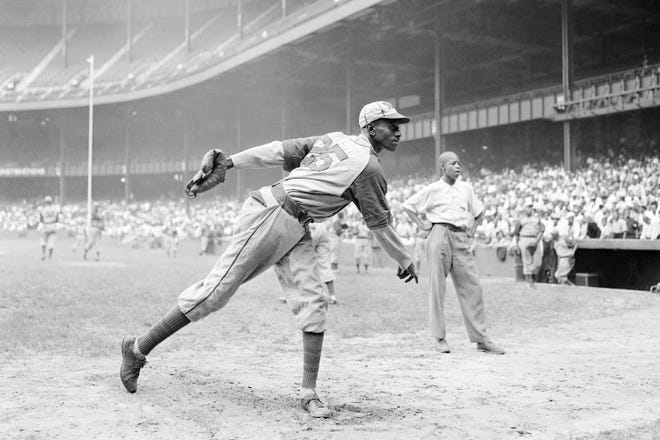 |
| https://www.scpr.org/programs/airtalk/2020/02/21/65341/looking-back-at-the-negro-leagues-centennial/ |
A Sense of Doubt blog post #2166 - MLB reclassifying Negro League as a Major League!
Hank Aaron died yesterday.
In a weird coincidence, I had been working on a post about MLB greats who died since early 2020, like Tom Seaver and Joe Morgan among many others.
That post will be published soon.
Meanwhile, I am taking a breather from all the politics with the post, which was going to be yesterday's post and then I got sent that great article from The National Review saying goodbye to Trump.
And so, since the other posts about the sad loss of many great players is not yet ready, here's this one about the acknowledgement of the Negro Baseball League as a major league, which will change the statistical references for the greatest players in the game, adding Josh Gibson and Satchel Paige among others to the ranks.
It's possible that once the merge is complete and the statisticians have their way with the numbers that Josh Gibson will be heralded as the greatest Baseball player of all time.
I never thought that Major League Baseball would ever make this move.
It's been a long time coming.
MLB reclassifies Negro Leagues as major league
NEW YORK -- Willie Mays will add some hits to his record, Monte Irvin's big league batting average should climb over .300, and Satchel Paige might add nearly 150 victories to his total.
Josh Gibson, the greatest of all Negro League sluggers, might just wind up with a major league record too.
The statistics and records of greats such as Gibson, Paige and roughly 3,400 other players are set to join Major League Baseball's books after MLB announced Wednesday that it is reclassifying the Negro Leagues as a major league.
MLB said Wednesday that it was "correcting a longtime oversight in the game's history" by elevating the Negro Leagues on the centennial of their founding. The Negro Leagues consisted of seven leagues, and MLB will include records from those circuits between 1920 and 1948. The Negro Leagues began to dissolve one year after Jackie Robinson became MLB's first Black player with the Brooklyn Dodgers in 1947.
Those leagues were excluded in 1969 when the Special Committee on Baseball Records identified six official "major leagues" dating to 1876.
"It is MLB's view that the Committee's 1969 omission of the Negro Leagues from consideration was clearly an error that demands today's designation," the league said in a statement.
MLB will work with the Elias Sports Bureau to review Negro Leagues statistics and records and figure out how to incorporate them into major league history. There was no standard method of record-keeping for the Negro Leagues, but there are enough box scores to stitch together some of its statistical past.
For instance, Mays could be credited with 16 hits from his 1948 season with the Alabama Black Barons. Irvin, a teammate of Mays' with the New York Giants, could see his career average climb from .293 to .304 if numbers listed at Baseball-Reference.com from his nine Negro League seasons are accurate. And Paige, who currently is credited with 28 major league wins, should add at least 146 to his total.
"All of us who love baseball have long known that the Negro Leagues produced many of our game's best players, innovations and triumphs against a backdrop of injustice," MLB commissioner Rob Manfred said in a statement. "We are now grateful to count the players of the Negro Leagues where they belong: as Major Leaguers within the official historical record."
While some have estimated Gibson slugged more than 800 homers during 16 Negro League seasons, it's unlikely that enough records exist for him to officially pass Barry Bonds for the career record at 762.
Depending on what Elias and MLB rule, though, Gibson could wind up with another notable record. His .441 batting average in 1943 would be the best season mark ever, edging Hugh Duffy's .440 from 1894. Gibson's line came in fewer than 80 games, however, far short of the modern standard of 162.
"We couldn't be more thrilled by this recognition of the significance of the Negro Leagues in Major League Baseball history," said Edward Schauder, legal representative for Gibson's estate and co-founder of the Negro Leagues Players Association. "Josh Gibson was a legend who would have certainly been a top player in the major leagues if he had been allowed to play."
MLB said it considered input from the National Baseball Hall of Fame and Museum, the Negro Leagues Researchers and Authors Group, and studies by other baseball authors and researchers.
"The perceived deficiencies of the Negro Leagues' structure and scheduling were born of MLB's exclusionary practices, and denying them major league status has been a double penalty, much like that exacted of Hall of Fame candidates prior to Satchel Paige's induction in 1971," baseball historian John Thorn said. "Granting MLB status to the Negro Leagues a century after their founding is profoundly gratifying."
Bob Kendrick, president of the Negro Leagues Baseball Museum in Kansas City, Missouri, also praised Wednesday's announcement.
"The Negro Leagues Baseball Museum is thrilled to see this well-deserved recognition of the Negro Leagues. In the minds of baseball fans worldwide, this serves as historical validation for those who had been shunned from the Major Leagues and had the foresight and courage to create their own league that helped change the game and our country too," Kendrick said in a statement.
"This acknowledgement is a meritorious nod to the courageous owners and players who helped build this exceptional enterprise and shines a welcomed spotlight on the immense talent that called the Negro Leagues home."
The Associated Press contributed to this report.
 |
| https://wamu.org/story/19/10/24/how-the-negro-leagues-homestead-grays-shaped-d-c-baseball/ |
5 ways baseball's all-time record books could change with Negro League stats added in
| Two Negro Leagues icons: Satchel Paige (left) and Josh Gibson, shown here in 1941. (Photo by Mark Rucker/Transcendental Graphics, Getty Images) |
Major League Baseball made a historic — and long overdue — announcement Wednesday, elevating the Negro Leagues to a major-league level. The decision is validation for more than 3,000 players who played in the Negro Leagues from 1920-1948 when MLB didn’t allow Black players. They’re now in MLB’s official record book. Their stats count. Their teams are officially recognized — their records officially stacked up alongside the established MLB numbers.
With this comes a new issue to sort out: How will adding all these stats to the all-time record book change baseball history as we know it?
MLB, its chief historian John Thorn and its official statistician Elias Sports Bureau are just starting down this path. The announcement didn’t come with any sweeping declarations of changes in the record books — and frankly, they aren’t expected to cause a tectonic shift — but there’s still a lot of research to be done before anything becomes official.
The league endorsed the work of the Seamheads Negro League database, which has been digging up Negro Leagues box scores and stats for 20 years. But it continues to unearth new information, so there’s not an endpoint in sight.
Unofficially, the news of the Negro Leagues going into the record books already has fans and pundits considering what changes could be coming. Here are five notable ones.
Where does Josh Gibson rank in homers?
Gibson, referred to as the Black Babe Ruth in his day, is the best hitter the Negro Leagues ever saw. He’s one of the most widely recognized Negro Leagues stars, a Hall of Famer already and a man with his own mythology. While folklore has him hitting 800 homers, lots and lots of those weren’t during what’s being considered the major leagues here. His official homer count for this time period, as currently verified and counted by the Seamheads database, is 238. That ties him for 264th all-time with the likes of Ray Lankford and J.D. Martinez.
Is Josh Gibson’s .441 season the best ever?
Where Gibson may have a claim to history is the single-season batting average mark and the most recent .400 season. He hit .441 in 1943, which would top Hugh Duffy’s .440 in 1894 and be a more recent .400 season than Ted Williams’ .406 in 1941.
The big difference here is the length of seasons. Gibson’s .441 came in 78 games with 342 plate appearances, while Williams played 143 games with 606 plate appearances. Duffy’s mark came in a season with 125 games and 616 plate appearances.
Willie Mays, now with more hits and possibly more homers
Willie Mays is one of the biggest stars who also played in the Negro Leagues, albeit for a short time. Before he debuted with the New York Giants, Mays played one season for the 1948 Birmingham Black Barons and had 17 hits, 10 of them coming during the playoffs. Nonetheless, this merging will affect his career hit total.
It won’t really move him around the all-time hit list at this point. He’s No. 12 all-time with 3,283 and would need 32 more hits to tie Eddie Collins at No. 11, but it could affect who’s coming next. Albert Pujols is currently 15th all-time with 3,236.
Mays also hit at least one home run during that season with the Black Barons, but as The Ringer notes, a box score hasn’t been found to accompany the game story that has been uncovered. That could eventually change his home run total, which memorably stands at 660.
Bob Feller has some company in Leon Day
While the list of official no-hitters is certainly getting longer — Satchel Paige, Smokey Joe Williams and others threw them — one noticeable change will be that Bob Feller won’t be the only pitcher with an opening day no-hitter anymore.
Leon Day threw one in 1946 for the Newark Eagles, and his comes with a little bit of added historical coolness: Day hadn’t pitched since 1942 after being drafted into World War II. That opening day start in 1946 was his first since returning from duty.
Satchel Paige’s legacy gets much stronger
Paige is perhaps the most well-known pitcher from the Negro Leagues, having pitched in MLB for five seasons in his 40s (and returning for one game at 59 years old!). He’s already a Hall of Famer, but the record books will now be a more accurate representation of his career.
With the merging of the stats, he stands to gain 115 wins over 18 seasons. Added to that are 112 complete games, 25 shutouts, 1,524 strikeouts and a fantastic 2.36 ERA over 1,536 innings. Again, shorter seasons in the Negro Leagues limit him from matching the cumulative numbers of some of MLB’s great starters (his win total is 143), but his story is now better told as one of the most important pitchers in baseball history.
One stat that won’t change: Hank Aaron’s home run total
One thing that would have caused a tectonic shift in the record books was if Hank Aaron’s 1952 season in the Negro Leagues counted. He hit either eight or nine home runs that season, depending on the source, but Barry Bonds sits atop the all-time home run leaderboard by seven, so either one of those being accepted would have made Hank No. 1 again.
Alas, the 1948 cutoff was chosen because most of the top talent fled the Negro Leagues after Jackie Robinson broke the color barrier, making the leagues more like the minor leagues than the majors by the time Aaron arrived.
 |
| https://www.latimes.com/sports/story/2020-08-09/negro-leagues-100th-anniversary-triumph-amid-racial-inequality |
 |
| https://theconversation.com/on-the-100th-anniversary-of-the-negro-leagues-a-look-back-at-what-was-lost-129678 |
 |
| https://theundefeated.com/features/on-this-day-in-black-history-its-time-for-some-negro-league-baseball-opera-performances-surface-and-finally-a-professional-basketball-team/ |

| https://www.ebbets.com/pages/negro-leagues |
Negro Leagues veteran Ron Teasley on MLB's 'wonderful gesture,' Satchel Paige and Josh Gibson
Major League Baseball's recognition last week of the Negro Leagues as part of the sport's official record has sparked renewed interest in those players, their exploits and their stories.
While there aren't many players still alive to celebrate the decision, Ron Teasley – a former member of the New York Cubans– has been fielding congratulatory phone calls since the Dec. 16 announcement.
"I've known for some time that Negro Leagues were major league and I always felt that the players who played were major league players," Teasley tells USA TODAY Sports in an exclusive interview. "But I think it was a wonderful gesture from Major League Baseball to confirm that."
Teasley, 93, remembers his father taking him to Negro League games in his native Detroit and being captivated by the buzz around the ballpark.
"I always noticed that if Satchel Paige was at the game, it was a tremendous feeling among the fans," he says.

Later when he became a semi-pro player with a local team, the Motor City Giants, he got a chance to play against Paige in an exhibition game.
"The first time I faced him, I hit a triple off Satchel Paige. I was just amazed at that," he says. But the feeling of "walking on air" didn't last long. Paige struck him out his next time up.
At least 70 years later, Teasley's memories of Paige are still vivid.
"He would go over and throw up maybe 10 pitches (to warm up). He didn't throw many more pitches than that because he wanted to save his arm," Teasley recalls.
"He was traveling from city to city as a star attraction. He would come in and pitch three or four innings and then leave and then head for the next town. The crowds would give him a big hand as he was leaving the park."
Another time Teasley was playing for the Toledo Crawfords against a Boston Braves team that included Hall of Famers Buck Leonard and Josh Gibson.
In an exhibition game in St. Louis, Gibson went homer-less, but that wasn't enough.
"Buck Leonard, in the last inning, he came up with a man on base. We thought we had him out on a good 2-2 pitch. The umpire called it a ball. The next pitch, Buck hit a home run over the left field fence to win the game."
Gibson got his revenge the next night in Hamilton, Ontario, hitting a home run over the center field fence. "It was 402 feet," Teasley remembers. "At that time, a 400-foot home run was a big deal because the baseball was not as live as they are now."
Similar stories about Gibson's exploits were everywhere. Teasley remembers playing with a semi-pro team when one of his teammates had an idea.
"We played in about five different cities ... This gentleman said to me, 'I'm going to find the oldest person in this park and ask him who hit the longest home run,'" Teasley says. "In each one of these parks, the person that they asked that question, they always said Josh Gibson."
Teasley finally made it to the Negro National League in 1948 when he signed with the New York Cubans. There, Gibson's legend only grew.
"They would talk about the home run he hit at Griffith Stadium (in Washington) -- right center. They said it was the longest home run they'd ever seen. Also the home run he hit at Yankee Stadium. He was really a type of player who stood out. Other players were amazed at his strength and his power," he says.
"There were so many stories about him, I thought he was Superman."
Teasley also remembers the day Jackie Robinson signed with the Brooklyn Dodgers and changed the face of baseball. His touring team was on its way to a game and had stopped in Warren, Ohio, to make sure the game was still on. The loss of Robinson effectively shut the league down, so his team turned around and headed back to Detroit.
As the Negro Leagues began to fold, Teasley and many others ended up playing in Canada. His playing career didn't last much longer. But he went back to school, got a degree in physical education, and returned to Detroit -- where he coached baseball.
As MLB begins adding approximately 3,400 Negro League players from 1920-1948 into its records, Teasley will be included. As a former major leaguer, he says he'll look into seeing if he qualifies for an MLB pension.
 |
| https://nlbm.com/negro-leagues-history/ |
+++++++++++++++++++++++++++++++++++++++++++++++++++++++++++++++++++++++
+++++++++++++++++++++++++++++++++++++++++++++++++++++++++++++++++++++++
- Bloggery committed by chris tower - 2101.22 - 10:10
- Days ago = 2030 days ago
- New note - On 1807.06, I ceased daily transmission of my Hey Mom feature after three years of daily conversations. I plan to continue Hey Mom posts at least twice per week but will continue to post the days since ("Days Ago") count on my blog each day. The blog entry numbering in the title has changed to reflect total Sense of Doubt posts since I began the blog on 0705.04, which include Hey Mom posts, Daily Bowie posts, and Sense of Doubt posts. Hey Mom posts will still be numbered sequentially. New Hey Mom posts will use the same format as all the other Hey Mom posts; all other posts will feature this format seen here.
/arc-anglerfish-arc2-prod-dmn.s3.amazonaws.com/public/VEB4WTVEM76AQVN6XCO4ZU4Z3A.jpg)



No comments:
Post a Comment